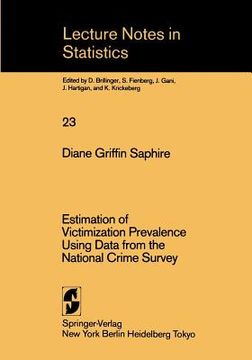Share
estimation and victimization prevalence using data from the national crime survey (in English)
D. G. Saphire
(Author)
·
Springer
· Paperback
estimation and victimization prevalence using data from the national crime survey (in English) - Saphire, D. G.
$ 104.20
$ 109.99
You save: $ 5.79
Choose the list to add your product or create one New List
✓ Product added successfully to the Wishlist.
Go to My WishlistsIt will be shipped from our warehouse between
Monday, June 10 and
Tuesday, June 11.
You will receive it anywhere in United States between 1 and 3 business days after shipment.
Synopsis "estimation and victimization prevalence using data from the national crime survey (in English)"
The National Crime Survey is a sample survey of housing units conducted by the U.S. Bureau of the Census. All eligible occupants of a sampled unit are interviewed every six months (for up to seven interviews) about victimizations that they have experienced during the previous six months. In this monograph several longitudinal analyses are performed using a subsample of the data covering the years 1973 through 1975. In particular. several methods of estimating the proportion of units that are crime-free for a given year. denoted by 8. are discussed. First. several ad hoc. as opposed to model-based. estimators of 8 are discussed. including those used by the Bureau of Justice Statistics. We find models under which these estimators are consistent for 8. One such model fits the data very well. A superpopulation approach to the estimation of 8 is then taken. assuming that the nonresponse and sampling mechanisms are ignorable. Three models are fit to the data: i) a homogeneous Bernoulli model. under which victimization is independent from month to month ii) a correlated Bernoulli model. under which victimization in any two months has positive correlation p. and iii) a two-state Markov model with states "victimized" and "crime-free". The correlated Bernoulli model is found to be very inadequate. The other two models fit the 1975 data well. but have rather poor fits to the 1973 and 1974 data. Rotation group biases are conjectured to be the cause of these poor fits.
- 0% (0)
- 0% (0)
- 0% (0)
- 0% (0)
- 0% (0)
All books in our catalog are Original.
The book is written in English.
The binding of this edition is Paperback.
✓ Producto agregado correctamente al carro, Ir a Pagar.

